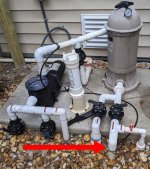I have a Pentair Rainbow Model 300 trichlor feeder. (It only gets used when I'm out of town.)
I haven't had it dialed on in months, but there is a drip leak on the outlet side tubing at the pipe collar going into the return line. I ordered a well-reviewed (always taken with a grain of salt) kit of fitting replacements from Amazon.
I have some questions:
(1) I would think that if I'm getting leaking at the outlet fitting into the return line even though the feeder is dialed off, the control dial must not be closing off the flow properly. Right, wrong, or maybe?
(2) The replacement kit elbow does not have a check valve in it. It doesn't rattle and I can blow through it just as easily in both directions. I'm not even sure why it would need a check valve to function, but I gather from looking at the manual that the stock elbow has a check valve. What disasters could I invite by installing an elbow with no check valve?
(3) If my feeder in its current state (I bought my pool with the house and don't know what the previous owner did with it) has a check valve in that elbow, I don't think it's functioning. If one follows Pentair's instructions for filling the feeder, you're supposed to dial the control valve off, take the cap off, and fill the feeder with the pump running. The instructions specifically state that the check valve will prevent the feeder from filling with water. Well, it fills with water when I tried that method. But maybe that's part of a faulty dial. Thoughts?
Thanks, as always, to anyone who can shed some light on this for me.
I haven't had it dialed on in months, but there is a drip leak on the outlet side tubing at the pipe collar going into the return line. I ordered a well-reviewed (always taken with a grain of salt) kit of fitting replacements from Amazon.
I have some questions:
(1) I would think that if I'm getting leaking at the outlet fitting into the return line even though the feeder is dialed off, the control dial must not be closing off the flow properly. Right, wrong, or maybe?
(2) The replacement kit elbow does not have a check valve in it. It doesn't rattle and I can blow through it just as easily in both directions. I'm not even sure why it would need a check valve to function, but I gather from looking at the manual that the stock elbow has a check valve. What disasters could I invite by installing an elbow with no check valve?
(3) If my feeder in its current state (I bought my pool with the house and don't know what the previous owner did with it) has a check valve in that elbow, I don't think it's functioning. If one follows Pentair's instructions for filling the feeder, you're supposed to dial the control valve off, take the cap off, and fill the feeder with the pump running. The instructions specifically state that the check valve will prevent the feeder from filling with water. Well, it fills with water when I tried that method. But maybe that's part of a faulty dial. Thoughts?
Thanks, as always, to anyone who can shed some light on this for me.


